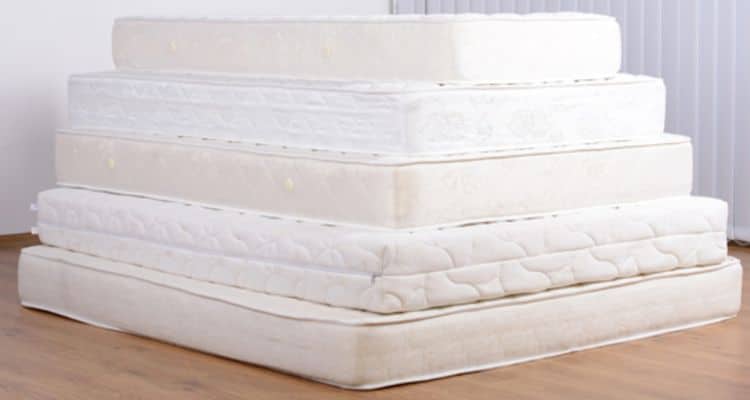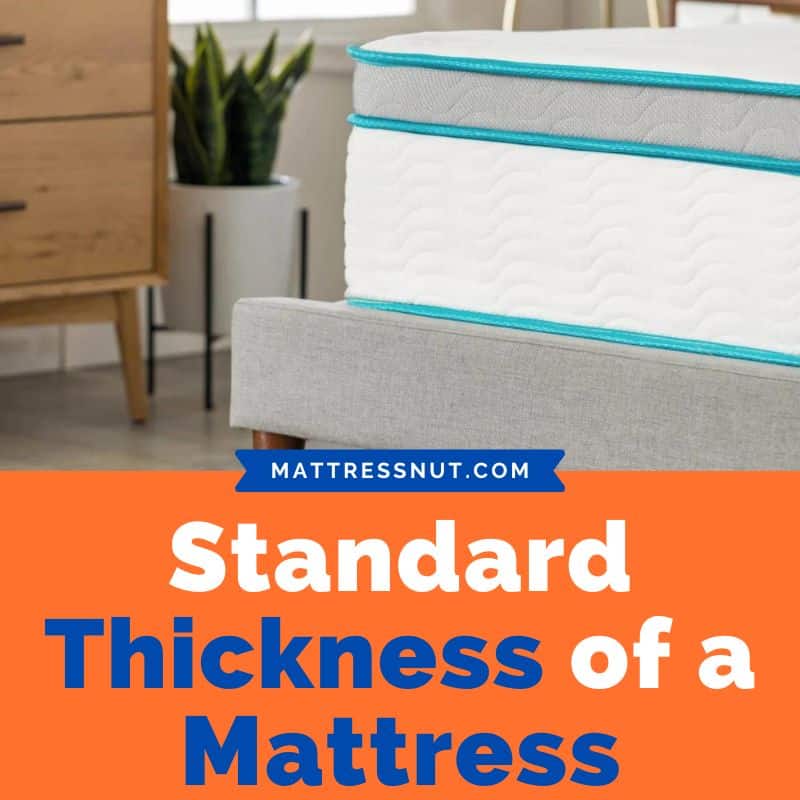Mattresses tend to differ in terms of how thick they are. Some can be seriously thick, while others tend to be thinner. But the overall thickness of a mattress depends upon how many layers are there and the thickness of each layer.
Of course, your mattress will be more comfortable and durable with more layers. A thin mattress can be more supportive. In this guide, we will determine the standard thickness of a mattress and the minimum thickness mandatory for maximum durability and comfort.
So, continue reading till the end to find out.
How Thick Should a Mattress be? Thickness Chart

When it comes to mattress thickness, there are no regulatory standards. And most of the units fall anywhere between 8 inches to 14 inches in thickness. The following list will give you an idea of how these mattresses are categorized depending on their thickness.
| Mattress Type | Thickness |
| Low-profile mattresses | 2 inches to 5 inches |
| Slim mattresses | 5 inches to 8 inches |
| Standard mattresses | 8 inches to 12 inches |
| Tall, thick, or deep mattresses | 12 inches to 16 inches |
| Extra tall, extra-thick, or different deep mattresses | Over 16 inches |
You will see that the first two mattress categories fall in the thinner class. But there is a difference between a low-profile and a slim mattress. Low-profile mattresses are usually air mattresses, or you will find them in cribs or even fold-away beds.
These mattresses work well for toddlers, and you can use them in your guest rooms for occasional use. But they are not sturdy enough for regular use and tend to break down quickly.
Slim mattresses have layers of foam in them, and they are more durable and comfortable. These mattresses can conveniently accommodate adults(check 10 top quality mattresses). But with the increasing number of layers, the mattress becomes thicker and much more comfortable.
With higher thickness, a mattress becomes less supportive of spending on the materials used in the construction. Thicker mattresses are also more expensive (check 10 amazing mattresses under 2,000 dollars). So, a better option is to balance it all out, and the ideal thickness falls between 8 inches to 12 inches and even 14 inches.
Elements of Mattress Thickness
The overall depth of any mattress relies heavily on the thickness of each layer that is part of the mattress design. Most mattresses have a dual-layer construction.
But high-quality mattresses come with 3 or 4 and even more layers in them. Each of these layers is made of different materials, and they directly influence your mattress’s overall support, cushioning, and longevity.
Base and comfort are the two basic layers in all mattresses. Let’s have a look at these two layers in a bit more detail and find out what purpose they serve.
Comfort layer
This layer is the top layer of a mattress, and it most often comes with a plush configuration in some mattress types like innerspring mattresses. This comfort layer is often made of poly-foam, wool, or cotton.
A pillow top is a surface layer made of soft materials and is directly stitched or packed into the mattress cover. Other mattress types, including hybrid (check the best selling hybrid mattresses), latex, or memory foam, come with a comfort layer made of memory foam or latex.
But their base layers are made of various materials. Their overall contouring and pressure-relieving features rely on the feel and firmness configuration of the comfort layer on top.
These comfort layers can be around 2 to 3 inches thick and provide appropriate cushioning and support. Some beds might have more than just one comfort layer.
This type of construction makes them plusher as they might also come with different sleep technologies. These include various cooling features and specifically targeted spine and hip support.
Base layer
This foundation layer tells you about the overall durability of the mattress. Most high-quality mattresses have over 50 percent of the overall thickness of the mattresses in their base layer.
For example, if you have a 12-inch thick mattress, its base layer will be more than 6 inches thick. Mattresses with thicker base layers tend to be more durable because a thicker base layer prevents the mattresses from sagging (also check the top rated toppers for sagging mattress).
Conventional innerspring mattresses, as well as hybrid mattresses, have coils in their base layers. And most memory foam mattresses have poly-foam in their base layer. Latex beds might have poly-foam or latex foams in their base layer.
Factors to Consider When Choosing Mattress Thickness

If you want to go for the most durable mattresses that can last longer and stay comfortable for a long time, you should go for more than 8-inch thickness.
Hence, the minimal requirements of its comfort layer thickness will range between 2 inches to 3 inches. In contrast, the thickness of the base layer would be around 5 to 6 inches.
Usually, the overall thickness of a mattress means that it will feel much softer. But there are some other factors that you must also consider in this regard.
Sleeping position
Thickness levels can influence the overall feel of the mattress. It can ultimately impact sleep quality, and your sleep position preferences don’t matter here. Certain sleeping positions need more cushioning, and others need more support. With different sleep positions, you need to go for different mattress thicknesses.
Side sleepers
People who prefer to sleep on their sides should go for mattresses that are around 12 inches to 14 inches thick. These mattresses for side sleeper need plenty of cushioning to relieve pressure on the shoulders and hips.
Back sleepers
People who prefer to sleep on their backs should also choose mattresses ranging from 12 inches to 14 inches. These mattresses ensure proper support while focusing on the spine’s natural curvature and preventing spinal misalignment (also check 10 great mattresses for back pain).
Stomach sleepers
People who prefer to sleep on their stomach or belly should go for mattresses 10 inches in thickness. This mattress for stomach sleeper reduces spine misalignment, and the ideal option is to go for a mattress with a thinner comfort layer for the sleep surface to be slightly on the firmer side so your hips don’t sag.
Combination sleepers
People who are combo sleepers should choose to go for mattresses around 12 inches in thickness, and they should come with a medium configuration. These people keep changing their sleep position during their sleep, so they need a mattress that guarantees a balance between softness and firmness.
Body type
Your body weight contributes a lot to how your sleep surface performs for you when you lie on it.
Lightweight sleepers (weighing under 130 lbs)
The ideal mattress thickness for these people is 12 inches. Thicker comfort layers conform to better, and they provide enough pressure relief to them.
Average sleepers (weighing between 130 lbs and 230 lbs)
These people should go for mattress thickness between 10 and 12 inches because these slip surfaces provide support and comfort.
Plus-size sleepers (weighing over 230 lbs)
These people should go for mattresses that are 12 inches to 14 inches thick and have a comfort layer at least 6 inches thick to prevent mattress sinkage.
Benefits & Drawbacks of Thick Mattresses
This section will look at the positives and negatives associated with using thick mattresses.
Benefits
- Thick mattresses provide more cushioning that is ideal for side sleepers.
- These mattresses tend to withstand heavier sleepers as thinner mattresses tend to sag.
Drawbacks
- Thick mattresses are expunged as they come with more layers and materials.
- They are heavier, making them tough to lift and move.
- They seem a bit too tall for people with limited mobility when they want to get in or out of bed.
-
What is the ideal mattress thickness for back pain relief?
The ideal mattress thickness for back pain relief is usually between 12-14 inches. This provides enough cushioning to support the contours of your spine while not being so thick that it throws your spine out of alignment. A medium firm mattress around 12 inches thick is usually recommended by chiropractors and orthopedists for back pain.
-
How does mattress thickness affect motion transfer?
Thicker mattresses are generally better at isolating motion transfer between sleep partners. The extra foam layers act as buffers to absorb movement before it spreads across the mattress. For couples, a thicker mattress usually means less disturbance when your partner changes positions or gets in and out of bed.
-
Do you need a box spring with a thicker mattress?
Most thicker mattresses (over 12 inches) do not require a box spring. The extra foam layers provide enough support on their own without needing the added foundation of a box spring. Platform beds or adjustable bases are usually sufficient support for thicker mattresses. However, always check the manufacturer’s recommendations for whether a box spring is required.
Conclusion
The most suitable mattress thickness that you should go for ranges between 8 to 14 inches. But the ideal one should be chosen based on preferences, including sleep positions and body weight. A thicker mattress with more layers is far more comfortable than thin mattresses.
Standard mattress thickness FAQs
How thick is the average mattress?
Average mattresses tend to range from 8 inches to 14 inches in thickness. These mattresses are suitable for most sleepers out there and are even suitable for combination sleepers.
Is it better to have a thicker mattress?
It is not always a good option to go for a thicker mattress. These thicker mattresses are more expensive and heavy to move or lift. They are not very convenient or too tall for people with minimal mobility.
What thickness is a memory foam mattress best?
Top-quality mattresses made of memory foam with thicknesses ranging from 10 inches to 14 inches are good for providing your body with conforming support. They are durable and tend to last more than 10 years.
Is an 8-inch memory foam mattress thick enough?
8-inch mattress thickness is sufficient for sleepers who weigh less than 130 pounds. But these mattresses are better suited for toddler rooms or your guest room because they are best for occasional use.

